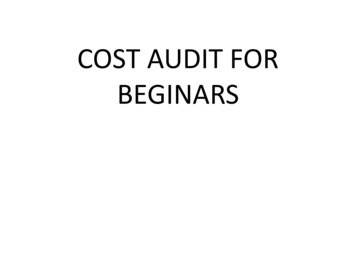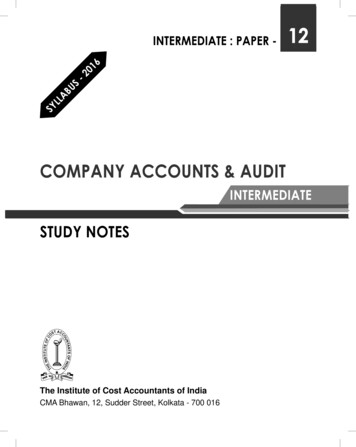
Transcription
COST AUDIT FORBEGINARS
Cost Audit comprises following; Verification of the cost accounting recordssuch as the accuracy of the cost accounts, costreports, cost statements, cost data and costingtechnique and Examination of these records to ensure thatthey adhere to the cost accounting principles,plans, procedures and objective.
Objectives of Cost Audit Prospective Objective: Underwhich cost audit aims to identifythe undue wastage or losses andensure that costing systemdetermines the correct andrealistic cost of production.
Objectives of Cost Audit Constructive Objectives: Cost auditprovides useful information to themanagement regarding regulatingproduction, economical method ofoperation, reducing cost of operationand reformulating Costaccounting plans .
Types of Cost Audit Cost Audit on behalf of the management:Cost audit on behalf of a customerCost Audit on behalf of GovernmentCost Audit by trade associationStatutory Cost Audit
Cost audit on behalf ofmanagement The principal object of the audit is tosee that the cost data placed beforethe management are verified andreliable and they are prepared insuch detail as will serve the purposethe management in takingappropriate decisions.
Cost audit on behalf of customer In case of cost plus contracts, thebuyer or contractee insists oncost audit to satisfy himselfabout the correct ascertainmentof cost.
Cost audit on behalf ofgovernment Government may order cost audit tosatisfy itself the genuineness of theindustry seeking the assistance. To establish fair price of any product,government may order cost audit.
Cost audit by trade association Where activities of trade associationinclude maintenance of price of theproducts manufactured by themember units or where pooling orcontribution arrangements, the tradeassociation require accuracy ofcosting information submitted bymember units checked.
Statutory cost audit This is covered by the provisionsof section 233B of the CompaniesAct.
Cost Audit Procedures Cost audit comprises following three steps;ReviewVerificationReporting
REVIEW The cost auditor should familiarisehimself with the memorandum andarticles of association, past auditreports on the financial accounts,annual reports issued by the board,the chairman’s speech, etc.
REVIEW Review the costing system in vogue in relationto the production process and method, Should have detailed knowledge of the flow ofproduction process and documents that ariseor received in that course. A list of cost account books maintained byclient should also be obtained.
Review Careful study and evaluation of internalcontrols and their operation on the costaccount books.
Review Before audit work is taken up, allbooks and records should be postedup to date, vouchers for the varioustransactions filed serially and allworking sheets made available to theauditors.
Review Audit should be conducted with utmost co –operation of the staff. Auditor should have knowledge of variousstandards issued by the Institute.
Cost accounting standardsCAS1Classification of CostCAS 2Capacity DeterminationCAS 3OverheadsCAS 4Cost of Production for CaptiveConsumptionCAS 5Average (equalized) Cost ofTransportationCAS 6Material CostCAS 7Employee CostCAS 8Cost of UtilitiesCAS 9Packing Material CostCAS 10Direct ExpensesCAS 11Administrative OverheadsCAS 12Repairs And Maintenance CostCAS 13Cost of Service Cost CentreCAS14Pollution Control Cost*CAS 15Selling and DistributionOverheadsCAS 16Depreciation and AmortisationCAS 17Interest and Financing ChargesCAS 18Research and Development CostsCAS 19Joint CostsCAS 20Cost Accounting Standard onRoyalty and Technical Know-HowFeeCAS 21Cost Accounting Standard onCAS 22Cost Accounting Standard on
Verification A suitable programme for cost audit is made. The procedure and programme to be adoptedfor audit and the various forms anddocuments used for it should be laid down inAudit manual. The audit programme should be drawn out indetail, specifying each item of audit work tobe carried out.
Verification of capacities Examination of licensed capacity,installed and utilised capacities ofvarious products. Reasons for abnormal variance maynoted.
Verification of financial ratios Financial ratios such asProfit as percentage of capital emplyed,Profit as percentage of sales,Current assets as a percentage of currentliabilities, Net worth expressed as percentage of longterm borrowings and liabilities.
Verification of financial ratios Net worth expressed as a percentage ofcapital employed, Cost of production as percentage of capitalemployed, Cost of production as percentage of workingcapital.
Verification of production data Production in quantities for various productsunder reference. Percentage of production of the product inrelation to installed capacity.
Verification of cost of raw materialsconsumed Verify the method of accounting followed forrecording the quantities and value of receipts,issues and balances of all materials used inproduction. Verify consumption of major raw materials perunit of production compared with thestandard requirement.
Verification of cost of raw materialsconsumed Verify variation in consumption of major rawmaterials per unit of production as comparedto the preceding two years. Verify confirmation received form the prartiesto whom materials are loaned. Verify the system or return of scrap andwastage.
Verification of cost of power & fuel Verify the adequacy of records maintained toascertain the cost of power, fuel, steam etc. If purchased, it should be shown seperately. Allocation of power cost to departments andproducts has to be verified.
Verification of employee costs Verify the total man-days of direct laboravailable and actual worked in the year. Verify the labor cost per unit of product orproducts under reference. Variations as compared to the previous twoyears. Contribution of incentive schemes towardsincreasing productivity and effect on the cost.
Cost of stores Verify the system of stores accounting forrecording receipts, issues and balances. Non moving items have to be checked. Cost per unit of production has to be verified.
Verify provision for depreciation Method of depreciation adopted by thecompany. Verify depreciation provided comply with thatof companies act section 205 sub –sec 2 The basis of allocation of depreciation ofcommon assets to the different departments. The basis of charging depreciation to the costof products.
Verification over heads andallocation Variations as compared to the previous twoyears. Basis of allocation of overhead to cost centresand absorption to products. Comparison of actual with budget and reasonsfor variation. Amount of expenditure compared to thevolume of output.
Royalty and Technical aid payments Verify the record of basis of calculation andcharging of royalty and other allied paymentsto production cost.
Sales Sales in quantity and value for each of theproduct. Average sales realisation per unit. Variations compared with last two years.
Verification of abnormal, nonrecurring and special costs Strikes, lockouts, major breakdowns in theplants, substantial power cuts, seriousaccident etc., may affect production. Costs incurred during that period may verifiedand excluded from the product cost.
Verification of cost statements Determination of cost following the generallyaccepted cost accounting principles. Application of costing system appropriate tothe product. Consistency in the application of costingsystem and cost accounting principles. Verification of cost statements as toprescribed form and the prescribed content.
Verification of cost statements Elimination of material prior – periodadjustments. Abnormal wastes and losses and other unusaltransactions being ignored in determining ofcost of product. The Costing Accounting Records Rules alsoprescribe the proforma of the various coststatements.
Reconciliation with financial books The cost records should be reconciled with thefinancial books of account to ensure accuracy. The reconciliation should be done in such amanner the profitability of the product can becorrectly adjudged and reconciled with overall profit of the company. Variations should be correctly indicated andexplained.
Audit notes In the course of audit, the auditor records onworking papers the material facts observed. Clarifications and answers may be recorded. The power to obtain information andexplanations is a tool to accomplish the dutycast on auditor. He should know how to use. The auditor has to satisfy himself that theinformation and data collected and compiledtherein are correct and the cost of productiondetermined there form is fair.
Reporting With the help of the working papers, an auditreport is issued on completion of audit. It should summarise the final result of audit. Certificate regarding correctness of theaccounts should be include in the report. The report should consist of notes,obeservations and comments on the costaccounting system, financial position,
Reporting stores and spare parts, depreciation, sales,abnormal non- recurring costs, etc. The report may also highlight other points ofinterest like factors responsible for theincrease in cost of production. Suggestion regarding improvements andcorrective measures to be taken.
Cost Audit comprises following; Verification of the cost accounting records such as the accuracy of the cost accounts, cost reports, cost statements, cost data and costing technique and Examination of these records to ensure that they adhere to the cost accounting principles,










